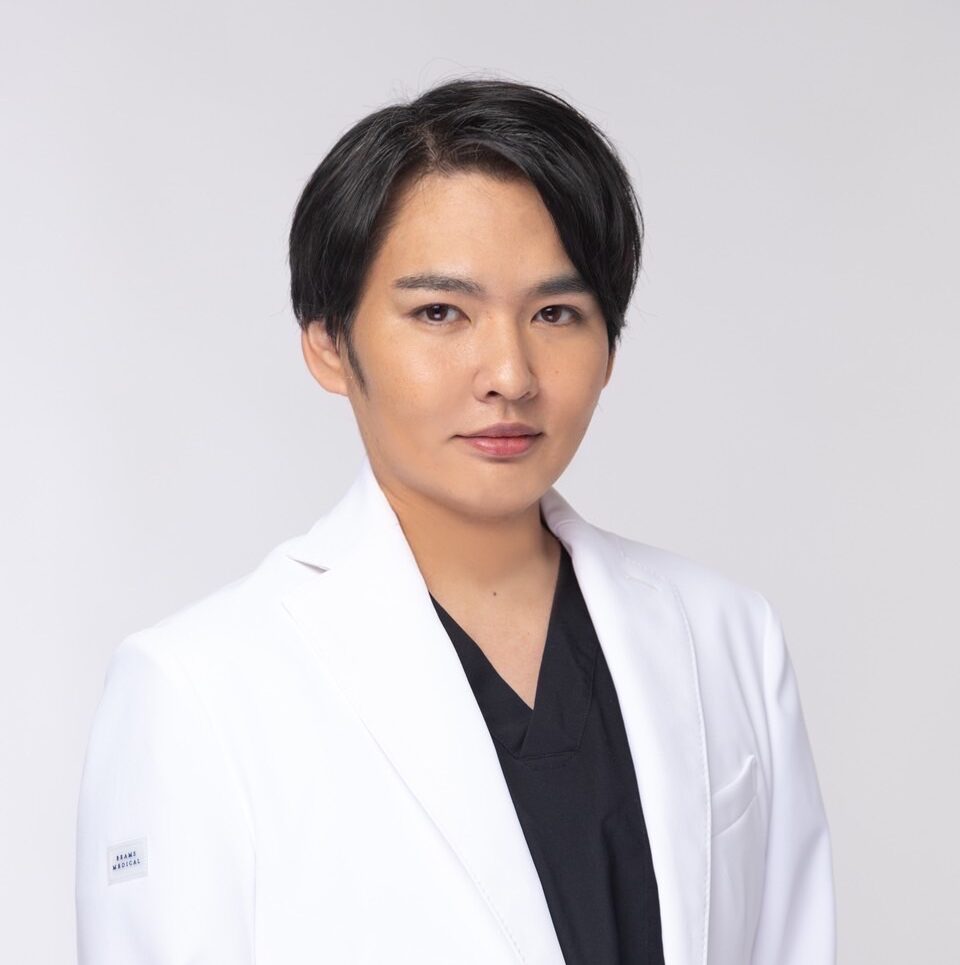Many people tend to dismiss "stiff shoulders" as "just tiredness," but there are some serious cases in which the pain is so severe that it makes it difficult to go about one's daily life. If the pain goes beyond "heavy shoulders" to "too painful to sleep" or "numbness up to the arms," it is not just muscle fatigue, but may be related to abnormalities in nerves, blood flow, or the skeletal structure.
In fact, in some cases, the pain can become chronic or even cause headaches, nausea, and other symptoms, and if left untreated, it risks a significant decrease in quality of life. Here, we provide a professional explanation of the causes, remedies, and appropriate treatment for those who feel that their stiff shoulders are too painful. Please refer to this information as a first step toward root cause improvement, rather than putting up with the symptoms.

Graduated from the Faculty of Medicine, National Kumamoto University. After serving as the director of major beauty clinics in Japan, etc., he opened Aladdin Aesthetic Clinic in 2023. He is a professional in aesthetic medicine with a doctorate in anti-aging research and many years of experience. With the motto of "Toward the realization of cosmetic medicine without lies," he aims to be the "Only One" together with his patients.
- Is it normal to have too much pain in the shoulder? What are the medical causes?
- What are the lifestyle and body habits common to people suffering from severe shoulder stiffness?
- Immediate Practice! Self-care and precautions to relieve overly painful stiff shoulders
- Can't cure stiff shoulders with over-the-counter medications or physical therapy alone? Medical treatments and options
- summary
Is it normal to have too much pain in the shoulder? What are the medical causes?
It is not uncommon to suffer from "stiff shoulders," but in some cases the pain can become unbearably severe. Assuming that it is simply fatigue or a postural problem can lead to misdiagnosis of the cause and missed opportunities for improvement. If the pain is severe and accompanied by numbness or nausea, deeper problems may be involved, not only in the muscles but also in the nerves and skeletal system.
In this section, we will explain why stiff shoulders can worsen to the point of becoming too painful, as well as the typical factors and different symptoms from a medical perspective. Please refer to this information to help you make the right decision to understand your symptoms.
Three typical factors that cause shoulder stiffness to become "severely painful
When stiff shoulders are accompanied by severe pain, there are three main factors
The first is muscle overstrain and impaired blood flow. When the same posture is maintained for long periods of time, such as at a desk, muscles become rigid, blood flow is impeded, and fatigue and pain-producing substances (bradykinin, etc.) tend to accumulate. This can cause chronic pain.
The second is nerve compression. This can be caused not only by cervical vertebrae but also by thoracic disc herniation, which may cause pain similar to stiff shoulders in the early stages, but as it progresses may cause serious neurological symptoms such as paralysis of the lower limbs and urinary problems. Early differentiation is important.
The third is skeletal and joint abnormalities. When abnormalities occur in the structures surrounding the joints and nerves, such as in the 40 shoulder (periarthritis) and cervical spondylosis, not only pain but also limitation of range of motion appears, and sharp pain is felt every time the shoulder is moved.
Not just muscle fatigue! Combined nerve, blood flow and skeletal triggers
Shoulder pain is not simply muscle fatigue, but is aggravated by a combination of multiple factors. For example, operating a smartphone for long periods of time can cause a hunched back, which can collapse the curve of the neck and back, causing pressure on the nerves.
In addition, chronic stress causes the sympathetic nervous system to become dominant, blood vessels to constrict, blood flow to deteriorate, and muscle repair to fail to keep up. Thus, the combined effects of muscle, nerve, blood flow, and skeletal triggers cause pain to become chronic and progress to a severe state of stiff shoulders.
Difference between common and severe shoulder stiffness
| Degree of Symptoms | Main Symptoms | Possible Causes | Guideline for Medical Examination |
|---|---|---|---|
| Mild stiffness in the shoulders | Dull lumpiness, heaviness | Muscle fatigue, poor posture | Improvement can be expected with self-care. |
| Severe stiff shoulders | Sharp pain, limited range of motion, prolonged | Nerve compression, degeneration of cervical and thoracic spine, poor circulation | If no improvement is seen, medical consultation is recommended |
| Symptoms requiring medical attention | Headache, numbness in arms, nausea, paralysis of lower limbs | Cervical spondylosis, thoracic disc herniation, 40 shoulder, etc. | See an orthopedic surgeon or neurologist early |
Abnormalities of the thoracic spine are particularly difficult to distinguish from common shoulder stiffness, and worsening due to neglect is considered dangerous. Evaluation by a physician, including diagnostic imaging, is important.
What are the lifestyle and body habits common to people suffering from severe shoulder stiffness?
In the previous chapter, we reported that when stiff shoulders are too painful, it is not only due to muscle fatigue, but also to a complex interplay of multifaceted problems involving the nerves, skeletal structure, and blood flow. Behind this is the existence of "habits" that we unconsciously accumulate in our daily lives.
Our casual posture, daily movements, and daily exposure to stress. All of these factors unknowingly put a strain on the body and turn stiff shoulders into pain. In this section, we will look at lifestyle habits and body usage that deepen the roots of pain and explore hints for improvement.
Accumulation of desk work/smart phone posture brings
Long hours at a desk or on a smartphone are unavoidable for modern people. These constantly force the neck and shoulders to work at unnatural angles, silently accumulating strain on the muscle groups that must continually support the head in defiance of gravity.
In particular, if the posture of hunching over or thrusting the neck forward is habitual, movement around the shoulder blades is restricted and the muscles tend to contract and harden. As a result, blood flow is blocked, oxygen and nutrients are not distributed, and substances that cause pain accumulate locally.
Although the shoulders and neck are the parts of the body that "move to maintain health," modern posture has blocked their natural function.
Focus on the relationship between stress and the autonomic nervous system.
Stiff shoulders are more than just a posture problem because the state of mind deeply affects the physical body. When we feel stress, the sympathetic nervous system becomes dominant among the autonomic nerves, causing blood vessels to constrict. This leads to poor blood flow and increased muscle tension, making it easier for stiff shoulders to become chronic.
In addition, when emotions such as anxiety and impatience persist, involuntary clenching of the teeth and shrugging of the shoulders frequently occur. This also contributes to muscle tension in the neck and shoulder area, which can further increase pain.
The fact that tension in the mind manifests itself as pain in the body is scientifically supported, and in many cases, an accumulation of mental load is behind those who feel too much pain in the shoulders.
Vicious cycle of cold, decreased blood flow and muscle tension
Many people report that shoulder pain is worse in the winter or in air-conditioned rooms. Cold constricts blood vessels, which interferes with circulation within the muscles and makes it difficult for fatiguing and inflammatory substances to be released. This leads to muscle stiffness and sharp pain with even the slightest movement.
In addition, cold and tension mutually reinforce each other. Cold causes the muscles to become stiff, and stiffness further aggravates blood flow. As this vicious cycle continues, the muscles around the shoulder become fixed in a "state of inability to relax" and turn into chronic pain that does not recover even with rest.
Examples of lifestyle habits that produce shoulder pain and directions for improvement
The following are examples of lifestyle habits that tend to aggravate stiff shoulders. If you can think of any of them, reviewing them little by little will be the first step toward fundamental improvement.
| Habits and habits | Burden likely to occur | Tips for Improvement |
|---|---|---|
| Long hours at a desk | Continuous tension in the neck and shoulders | Stand up every hour and utilize posture correction items. |
| Posture looking into the phone | Neck forward and load on the cervical spine | Keep your eyes high and adjust the angle at which you view the screen |
| Working in a cold room | Decreased blood flow, muscle stiffness | Warming the shoulder area and preventing direct exposure to cold air |
| Lack of sleep/shallow sleep | Insufficient muscle repair | Review bedding and refrain from using smartphones before bedtime |
| Mentally stressful life | Disturbance of autonomic nervous system, persistent muscle tension | Relaxation through light exercise, deep breathing, and bathing |
The accumulation of these habits may be behind the creation of stiff shoulder symptoms. It is not easy to change your mindset, but your body will steadily change according to your habits. Please try to incorporate correct knowledge and small efforts into your daily life.
Immediate Practice! Self-care and precautions to relieve overly painful stiff shoulders
Every day that you feel too much pain in your shoulders wears on your body and mind more than you can imagine. As we discussed in the previous chapter, there is a complex intertwining of factors behind this, including lifestyle habits, physical habits, and even cold and stress. However, there are things we can do right now to help us in the process of reviewing these underlying factors.
Here are some self-care methods that can be practiced on the spot by those who are experiencing pain right now, from a professional and easy-to-understand perspective. Not all methods are universal for everyone, but knowing the right care should be your first step toward pain relief.
Recommended by physical therapists? Shoulder stretches that work quickly
The more intense the pain, the more fear of moving or not knowing what to do tends to take precedence. However, the field of physical therapy has shown that stretching done correctly can be of great help in stimulating blood flow and loosening stiff muscles.
For example, the following simple stretches can relieve pressure on the muscles and nerves around the shoulder and help you feel refreshed and light in a short time.
- Sit in a chair with your back straight and slowly lift both shoulders close to your ears and hold for 5 seconds.
- Then drop your shoulders as if you were stoned and relaxed. Do three sets of this.
- Slowly pull the elbows in a comfortable manner to draw the shoulder blades together on the back side.
The key to all of these exercises is to do them slowly and without holding your breath. Also, stretching should be done within the range of what "feels good". Avoid movements that cause pain, and work with the mindset of gently relaxing.
Effects and Limitations of Acupressure Points and Heat Therapy
When stiff shoulders are too painful, pressure points and warmth are effective ways to meet the need to "do something about it now. In particular, a pressure point between the neck and shoulder called the "shoulder well" is believed to be related to improving blood flow and relieving muscle tension, and many experts recommend its use.
When pressing, apply light pressure with your fingers while repeatedly taking deep breaths, and stimulate slowly over a period of about 10 seconds. It is important to use pressure that feels "comfortable," as too much stimulation may have the opposite effect.
Another effective heat therapy is to apply a steamed towel or heating pad to the base of the shoulder for a few minutes. The warmth promotes blood flow, reduces muscle stiffness, and may also relieve pressure on nerves.
However, these are only temporary measures and are not intended to correct the underlying cause. If they need to be repeated day after day, or if they are ineffective, consultation with a medical institution is recommended as soon as possible.
NG care that should not be done and guidelines for self-diagnosis
When you feel too much pain in your shoulders, you may unintentionally resort to the wrong care out of impatience or anxiety. However, this often leads to worsening symptoms.
Below is a comparison of "coping strategies to avoid" and "recommended care".
| action | Reasons to avoid | Alternative recommended care |
|---|---|---|
| Forced neck rotation | Unnatural twisting of the cervical spine and possible nerve compression | Slow up-and-down shoulder movements and deep breathing |
| rub someone's shoulders | Risk of exacerbation in case of inflammation | Heat therapy and light stretching rather than acupressure |
| Intense stretching immediately after bathing | Muscles are too loose and joints are easily injured | Light exercises and keeping warm after bathing are effective. |
| Prolonged use of strong massage devices | Excessive stimulation may damage muscle fibers | Limit use to short, hypoallergenic use. |
In addition, if symptoms such as numbness, nausea, or difficulty with arm strength are present, this is a stage where self-directed self-care should be avoided and a visit to an orthopedic surgeon or neurologist should be a priority.
It is not uncommon for what is assumed to be a "stiff shoulder" to actually be another condition. Careful observation of the quality and duration of the pain and its relationship to other symptoms is the first step toward an appropriate response.
Can't cure stiff shoulders with over-the-counter medications or physical therapy alone? Medical treatments and options
In the previous chapter, we introduced self-care when you feel too much pain in your shoulders, but in cases that do not improve or repeatedly worsen, professional support from a health care provider is necessary.
If the pain is particularly strong and persistent, it is not simply muscle fatigue, but may be related to abnormalities in the nervous system, skeletal system, or circulatory function.
This section will focus on the role and use of orthopedics, neurology, and rehabilitation medicine as a method of medical care for shoulder pain.
Orthopedics, neurology, rehabilitation...where should I consult?
| Type of medical institution | Main Features | Suitable symptoms and situations |
|---|---|---|
| orthopaedic surgery | Diagnosis and treatment of structural abnormalities of bones, joints and muscles | Cervical spondylosis, 40 shoulder, joint degeneration, etc. |
| neurology | Specializing in pain and numbness caused by abnormal nerve transmission and compression | Trembling pain, numbness in arms and hands, lack of strength |
| Department of Rehabilitation | Prevent recurrence through improved posture and movement | Chronic stiffness in the shoulders from muscle usage habits and postural origins |
When one feels "too much pain in the shoulder," the first place to go is to see an orthopedic surgeon. Orthopedics confirms structural problems of the cervical spine and shoulder joint through imaging and palpation, and diagnoses and treats conditions such as cervical spondylosis, osteoarthritis, and shoulder pain. Especially in cases involving limited range of motion and numbness, initial orthopedic care is essential.
Second, neurology is also a very important department. If the nature of the pain is neurological, such as "twitching" or "throbbing," or if there are neurological symptoms such as numbness or weakness in the arm or hand, the cause may be the nerve rather than the muscle. Neurology can provide a precise evaluation that includes nerve conduction studies and their relationship to the brain and spinal cord.
The rehabilitation department then becomes the center of "fundamental treatment" to prevent recurrence of pain and improve body functions. It is characterized by the availability of individualized exercise guidance by physical therapists and lifestyle-based movement improvement, which is very effective for those who aim to "create a body that does not recur after treatment.
Botox injections and other cosmetic medical approaches
Apart from treatment by medical institutions, shoulder stiffness care utilizing cosmetic medicine has been attracting attention in recent years. A representative example is "trapezius muscle botulinum toxin injections. This involves injecting a botulinum drug into overstrained, raised shoulder muscles to temporarily relieve muscle tension.
It is said to provide a certain amount of relief for tension-type stiff shoulders, and is gaining widespread support from those who wish to "clear the lines of their shoulders while reducing painful stiffness.
However, the effects of Botox are limited to a few months and should be viewed as an adjunctive approach rather than a fundamental treatment. It must be performed in conjunction with a medical facility and under appropriate diagnosis.
Symptoms and self-checkpoints to be communicated at the time of consultation
When seeing a doctor, it is important to provide specific information such as where, how, and when the pain began.
Especially in a condition like stiff shoulders, where multiple factors are involved, it is important for patients to notice and record changes in their own bodies to help their doctors make decisions.
The following are some of the points you should check
- What triggered the onset of pain and the occasions when it worsened (e.g., prolonged work, waking up, etc.)
- Nature of pain (heavy, stabbing, electric)
- Pain site changes or spreads, unilateral or bilateral
- Presence of accompanying symptoms such as nausea, headache, numbness, etc.
- Coping strategies that you have tried and whether or not they are effective
By organizing this information, it will be easier to determine whether orthopedics, neurology, or rehabilitation medicine should be consulted.
summary
An overly painful shoulder is no longer a temporary ailment. It is a clear SOS from the body and an important sign that should not be left untreated. As introduced here, it is possible to approach the root cause of the pain through a combination of self-care by reviewing your daily posture and lifestyle, and professional treatment at a medical institution.
There is a reason for your pain, and if you take the appropriate action, you will certainly find a way to improve. Instead of choosing to "endure," I hope you will choose to "change. Today's step will be a big step toward a comfortable life tomorrow. I hope that the information here will help you to seriously confront your body.
At Aladdin Aesthetic Clinic, based on our many years of experience in cosmetic medicine and cosmetic dermatology and the knowledge of our doctoral degree, we provide counseling that aims to be "only one", offering the best treatment for each person we meet. We offer only the necessary treatments without any unnecessary information or suggestions.
Feel free to use our official LINE account for 24-hour counseling and reservations. Please feel free to contact us for free counseling for the first time or if you have any concerns.






